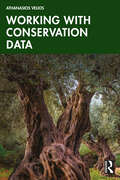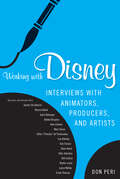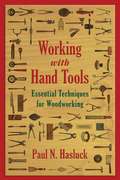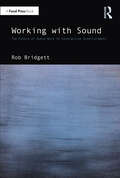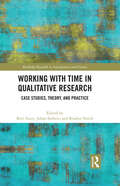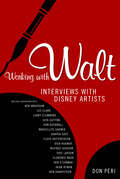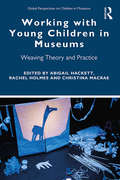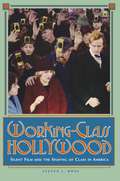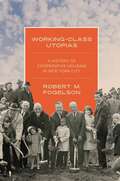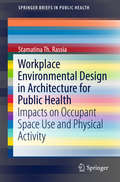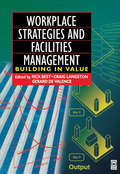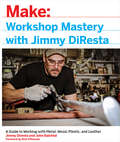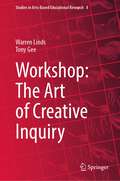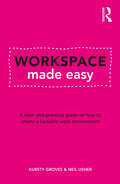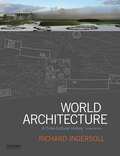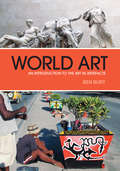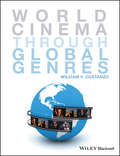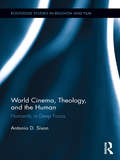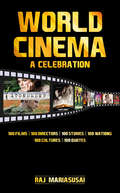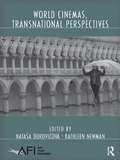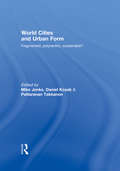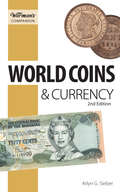- Table View
- List View
Working with Children in Contemporary Performance: Ethics, Agency and Affect
by Sarah AustinThis book outlines how an innovative ‘rights-based’ model of contemporary performance practice can be used when working with children and young people.This model, framed by the United Nations Convention on the Rights of the Child (1989), challenges the idea of children as vulnerable and in need of protection, argues for the recognition of the child’s voice, and champions the creativity of children in performance. Sarah Austin draws on rich research and practitioner experience to analyse Youth Arts pedagogies, inclusive theatre practice, models of participation, the symbolic potential of the child in performance, and the work of contemporary theatre practitioners making work with children for adult audiences. The combined practical and written research reflected in this book offers a new, nuanced understanding of children as cultural agents, raising the prospect of a creative process that foregrounds deeper considerations of the strengths and capacities of children.This book would primarily appeal to scholars of theatre and performance studies, specifically those working in the field of applied theatre and theatre for children and young people. Additionally, the practice-based elements of the book are likely to appeal to theatre professionals working in youth arts or theatre for young audiences or associated fields.
Working with Conservation Data
by Athanasios VeliosWorking with Conservation Data provides a practical, step-by-step guide that describes how to approach the issue of documentation in a professional conservation environment.Documentation forms an essential part of conservation work, allowing conservators to preserve essential information about objects over time. With the increasing popularity of digital tools for documenting conservation work, it is important that a solid framework for organising this information is in place. Each chapter within this book corresponds to an individual step of a larger process of documentation, providing readers with not only a reference for specific parts of the process, but also a thorough guide to implementing or improving a conservation documentation system. The book explores important concepts involved in the documentation of conservation, as well as research and practical questions, and an analysis of implicit information embedded within conservation data and how it can be used to answer conservation questions. It also outlines best practices for producing conservation data and recommendations for structuring and sharing conservation data, so that documentation records can be easily retrieved and combined with other data.Working with Conservation Data is an invaluable reference work suitable for conservators working on documentation projects, as well as professionals working in the computing and information departments of museums, galleries, libraries and archives.
Working with Disney: Interviews with Animators, Producers, and Artists
by Don PeriIn this volume Don Peri expands his extraordinary work conducting in-depth interviews with Disney employees and animators. These interviews include conversations with actors and performers rather than solely animators. This book offers Peri’s extensive interviews with Marc Davis, Frank Thomas, and Ollie Johnston, three of Walt Disney’s famed “Nine Old Men of Animation.” Peri interviewed two Disney Mouseketeers—Bobby Burgess and Sharon Baird—from the original Mickey Mouse Club Show, providing valuable perspectives on how the Walt Disney Company worked with television. Lou Debney, a Disney television producer, discusses the company’s engagement with television and live-action film. Walter Lantz talks about his work in the animation business, especially with Oswald the Lucky Rabbit. And Dave Hand discusses his legendary work on Snow White and the Seven Dwarfs. Taken together, the interviews in Working with Disney create an enlightening perspective on the Walt Disney Company as it grew from its animation roots into a media powerhouse.
Working with Hand Tools: Essential Techniques for Woodworking
by Paul N. HasluckAn all-in-one guide containing everything there is to know about woodworking hand tools.Whether you are a beginner with an idea in mind-and not a clue where to start-or an old pro with years of experience, you need the knowledge to ensure your project comes out right. From identifying and holding tools properly to constructing your own household furniture, Working with Hand Tools is your trusted resource for all things related to woodwork. Precise illustrations and design details provide a map for hundreds of woodworking projects, including: Sheds Trellises Tables Yard and garden accessories Fences Porches Furniture Cabinets And much more!This comprehensive guide to the tools and techniques of woodworking has been a favorite of both amateur and professional woodworkers for over a century. Readers will learn to make almost anything using only hand tools. With nearly three thousand illustrations, this definitive guide is an invaluable resource for any do-it-yourselfer. If it's wood, and there's work to be done, don't start without Paul N. Hasluck's essential guide.
Working with Sound: The Future of Audio Work in Interactive Entertainment
by Rob BridgettWorking with Sound is an exploration of the ever-changing working practices of audio development in the era of hybrid collaboration in the games industry. Through learnings from the pre-pandemic remote and isolated worlds of audio work, sound designers, composers, and dialogue designers find themselves equipped uniquely to thrive in the hybrid, remote, and studio-based realms of today’s fast-evolving working landscapes. With unique insights into navigating the worlds of isolation and collaboration, this book explores ways of thinking and working in this world, equipping the reader with inspiration to sustainably tackle the many stages of the development process. Working with Sound is an essential guide for professionals working in dynamic audio teams of all sizes, as well as the designers, producers, artists, animators, and programmers who collaborate closely with their colleagues working on game audio and sound.
Working with Time in Qualitative Research: Case Studies, Theory and Practice (Routledge Research in Anticipation and Futures)
by Keri FacerThis volume creates a conversation between researchers who are actively exploring how working with and reflecting upon time and temporality in the research process can generate new accounts and understandings of social and cultural phenomena and bring new ways of knowing and being into existence. The book makes a significant contribution to the enhancement of the social sciences and humanities by charting research methods that link reflectively articulate notions of time to knowledge production in these areas. Contributors explore how researchers are beginning to adopt tactics such as time visibility, hacking time, making time, witnessing temporal power and caring for temporal disruptions as resources for qualitative research. The book collects fields as disparate as futures studies and history, literary analysis and urban design, utopian studies, and science and technology studies, bringing together those who are working with temporality reflexively as a powerful epistemological tool for scholarship and research inquiry. It surfaces and foregrounds the methodological challenges and possibilities raised. In so doing, this collection will serve as a resource for both new and experienced researchers in the humanities and social sciences, seeking to understand the tools that are emerging, both theoretical and methodological, for working with time as part of research design. This book will be of great interest to students and scholars of research methods, time and temporality, future studies, and the environmental humanities.
Working with Walt: Interviews with Disney Artists
by Don PeriThis book includes interviews with Ken Anderson, Les Clark, Larry Clemmons, Jack Cutting, Don Duckwall, Marcellite Garner, Harper Goff, Floyd Gottfredson, Dick Huemer, Wilfred Jackson, Eric Larson, Clarence Nash, Ken O'Connor, Herb Ryman, and Ben Sharpsteen. Walt Disney created or supervised the creation of live-action films, television specials, documentaries, toys, merchandise, comic books, and theme parks. His vision, however, manifested itself first and foremost in his animated shorts and feature-length cartoons, which are loved by millions around the world. Working with Walt: Interviews with Disney Artists collects revealing conversations with animators, voice actors, and designers who worked extensively with Disney during the heyday of his animation studio. The book includes fifteen interviews with artists who directed segments of such classic animated features as Dumbo and Fantasia. Some interviewed were part of Disney’s famed team dubbed “The Nine Old Men of Animation,” and some worked closely with Disney on Steamboat Willie, his first cartoon with sound. Among the subjects the interviewees discuss are the studio’s working environment, the high-water mark of animation during Hollywood's Golden Age, and Disney’s mixture of childlike charm and hard-nosed business drive. Through these voices, Don Peri preserves an account of the Disney magic from those who worked closely with him.
Working with Wood
by Gilbert R. HutchingsThe authors of Working With Wood have endeavored to introduce beginning students to wood. To teach woodworking and keep motivation high, the text has been written in a "hands-on" manner.
Working with Young Children in Museums: Weaving Theory and Practice (Global Perspectives on Children in Museums)
by Rachel Holmes Abigail Hackett Christina MacRaeWorking with Young Children in Museums makes a major contribution to the small body of extant research on young children in museums, galleries and heritage sites. Bridging theory and practice, the book introduces theoretical concepts in a clear and concise manner, whilst also providing inspirational insights into everyday programming in museums. Structured around three key themes, this volume seeks to diverge from the dominant socio-cultural learning models that are generally employed in the museum learning literature. It introduces a body of theories that have variously been called new materialist, spatial, posthuman and Deleuzian; theories which enable a focus on the body, movement and place and which have not yet been widely shared or developed with the museum sector or explicitly connected to practice. This book outlines these theories in an accessible way, explaining their usefulness for conceptualising young children in museums and connecting them to practical examples of programming in a range of locations via a series of contributed case studies. Connecting theory to practice for readers in a way that emphasises possibility, Working with Young Children in Museums should be essential reading for museum practitioners working in a range of institutions around the world. It should be of equal interest to researchers and students engaged in the study of museum learning, early childhood education and children’s experiences in museums.
Working-Class Hollywood: Silent Film and the Shaping of Class in America
by Steven J. RossThis path-breaking book reveals how Hollywood became "Hollywood" and what that meant for the politics of America and American film. Working-Class Hollywood tells the story of filmmaking in the first three decades of the twentieth century, a time when going to the movies could transform lives and when the cinema was a battleground for control of American consciousness. Steven Ross documents the rise of a working-class film movement that challenged the dominant political ideas of the day. Between 1907 and 1930, worker filmmakers repeatedly clashed with censors, movie industry leaders, and federal agencies over the kinds of images and subjects audiences would be allowed to see. The outcome of these battles was critical to our own times, for the victors got to shape the meaning of class in twentieth- century America. Surveying several hundred movies made by or about working men and women, Ross shows how filmmakers were far more concerned with class conflict during the silent era than at any subsequent time. Directors like Charlie Chaplin, D. W. Griffith, and William de Mille made movies that defended working people and chastised their enemies. Worker filmmakers went a step further and produced movies from A Martyr to His Cause (1911) to The Gastonia Textile Strike (1929) that depicted a unified working class using strikes, unions, and socialism to transform a nation. J. Edgar Hoover considered these class-conscious productions so dangerous that he assigned secret agents to spy on worker filmmakers. Liberal and radical films declined in the 1920s as an emerging Hollywood studio system, pressured by censors and Wall Street investors, pushed American film in increasingly conservative directions. Appealing to people's dreams of luxury and upward mobility, studios produced lavish fantasy films that shifted popular attention away from the problems of the workplace and toward the pleasures of the new consumer society. While worker filmmakers were trying to heighten class consciousness, Hollywood producers were suggesting that class no longer mattered. Working-Class Hollywood shows how silent films helped shape the modern belief that we are a classless nation.
Working-Class Utopias: A History of Cooperative Housing in New York City
by Robert M. FogelsonOne of the nation’s foremost urban historians traces the history of cooperative housing in New York City from the 1920s through the 1970sAs World War II ended and Americans turned their attention to problems at home, union leaders and other prominent New Yorkers came to believe that cooperative housing would solve the city’s century-old problem of providing decent housing at a reasonable cost for working-class families. Working-Class Utopias tells the story of this ambitious movement from the construction of the Amalgamated Houses after World War I to the building of Co-op City, the world’s largest housing cooperative, four decades later.Robert Fogelson brings to life a tumultuous era in the life of New York, drawing on a wealth of archival materials such as community newspapers, legal records, and personal and institutional papers. In the early 1950s, a consortium of labor unions founded the United Housing Foundation under the visionary leadership of Abraham E. Kazan, who was supported by Nelson A. Rockefeller, Robert F. Wagner Jr., and Robert Moses. With the help of the state, which provided below-market-rate mortgages, and the city, which granted tax abatements, Kazan’s group built large-scale cooperatives in every borough except Staten Island. Then came Co-op City, built in the Bronx in the 1960s as a model for other cities but plagued by unforeseen fiscal problems, culminating in the longest and costliest rent strike in American history. Co-op City survived, but the United Housing Foundation did not, and neither did the cooperative housing movement.Working-Class Utopias is essential reading for anyone seeking to understand the housing problem that continues to plague New York and cities across the nation.
Workplace Environmental Design in Architecture for Public Health
by Stamatina Th. RassiaThis concise volume analyzes the potential for the workplace environment--where so many people spend so much of their day--to improve workers' capacity for health and wellness. It pinpoints the link between sedentary lifestyles and poor health, and explores the role of office spatial design in encouraging physical activity to promote physical activity, health and prevent disease. The featured research study tracks workers' movement in a variety of office layouts, addressing possible ways movement-friendly design can co-exist with wireless communication, paperless offices, and new corporate concepts of productivity. From these findings, the author's conclusions extend public health concepts to recognize that influencing population-wide levels of activity through office architectural design alone may be possible. This SpringerBrief is comprised of chapters on : Physical activity and disease: Theory and practice Space-use and the history of the office building Identifying factors of the office architectural design that influence movement, Interdisciplinary research methods in studying worker physical activity, decision-making and office design characteristics The KINESIS model for simulating physical activity in office environments The questions and potential for solutions in Workplace Environmental Design in Architecture for Public Health will interest and inform researchers in interdisciplinary topics of public health and architecture as well as graduate and post-graduate students, architects, economists, managers, businesses as well as health-conscious readers.
Workplace Strategies and Facilities Management
by Craig Langston Rick Best Gerard De ValenceThis book provides comprehensive coverage of issues that facility managers in the property industry need to understand and apply in the pursuit of value for money over the life span of built facilities. The authors introduce the fast-growing discipline of facility management, examine the core competencies that facility managers should possess and study different contemporary drivers of change. The book emphasises the need to consider facilities management issues at the pre-design stage of the construction process, rather than only when the building is completed, in order to maximise value for money.
Workshop Mastery with Jimmy DiResta: A Guide to Working With Metal, Wood, Plastic, and Leather
by John Baichtal Jimmy DiRestaJimmy DiResta has made a name for himself with his inventiveness and workshop skills, creating dozens of projects for YouTube videos and television shows such as Hammered and Against the Grain on the DIY network. In Make: Workshop Mastery With Jimmy DiResta, Jimmy and co-author John Baichtal teach readers essential workshop skills with over a dozen projects that explore everything from mold-making to CNC routing on to metalsmithing.Projects in this book include:Tool-drawer cabinetA chess setOne-sheet metal stoolA macheteCrowbar-hammer mashupAn electric guitar with a carved bodyYour own signA leather backpack
Workshop: The Art of Creative Inquiry (Studies in Arts-Based Educational Research #8)
by Warren Linds Tony GeeThis book explores tools and techniques for creating the arts with groups. It provides insights into why workshops are such an effective and relevant form of creative practice. Throughout, two experienced practitioners share successful principles and qualities. They also include examples of workshops that explore ways of facilitating creative exploration.The authors believe that underpinning any good workshop practice is an understanding of what constitutes a workshop. This is a process in which the relationship between artist/researcher and participant/audience, maker, and witness is fluid. It extends each individual’s abilities and connects doing to learning to inquiring in a single process. The book itself is a dialogue on, and an investigation into, this practice. It fully explores the specificities of workshop practice in relation to how it engages others in arts-based research.Readers learn how workshops involve inquiry into six areas: inquiry into subjects, artistic processes, skills, self, the world, and relationships with others. In the end, this informed investigation helps practitioners to better reflect on their own approaches to arts-based inquiry and research. This, in turn, leads to a better understanding of how readers can use workshops for the maximum benefit of all participants, both individuals and groups.
Workspace Made Easy: A clear and practical guide on how to create a fantastic work environment
by Kursty Groves Neil UsherDemystifying the entire workspace industry, for the non-expert and expert alike, this unique book sets out every step and consideration in how to lead a project to create a fantastic workspace.Entirely free of baffling jargon and industry-speak, it’s a refreshingly accessible, practical, down-to-earth guide applicable to all types of workspace, new or renovated and anywhere in the world. Created by two leading workspace practitioners with over half a century of combined multi-sector international experience, this book maps the process from initial idea to finished product and beyond in a succinct, logical and easy-to-follow question and answer style. It helps the reader instantly become a better project leader, and, for all those firms they’ll deal with, a more informed and prepared client.Supported by amusing and informative true stories throughout, the book is an indispensable guide that is sure to become an industry standard.
World Architecture: A Cross-Cultural History
by Spiro Kostof Richard IngersollWorld Architecture: A Cross-Cultural History is a comprehensive survey of architectural activity from prehistoric times until today. This book addresses architecture both as a practical solution to the problems of everyday life and as a special, symbolic artifact resulting from the desire for poetics.
World Architecture: A Cross-cultural History (Sinauer Ser.)
by Richard IngersollRichard Ingersoll's World Architecture: A Cross-Cultural History, Second Edition, provides the most comprehensive and contemporary survey in the field. Each chapter within the text's chronological organization focuses on three unique architectural cultures, giving instructors the flexibility to choose which traditions are the most relevant to their courses. The text also provides students with numerous pedagogical tools, including timelines, comparative maps, a glossary, and text boxes devoted to social factors and specific issues in technology and philosophy. The result is a compendious method for understanding and appreciating the history, cultural significance, beauty, and diversity of architecture from around the world.
World Art: An Introduction to the Art in Artefacts
by Ben BurtWhat do we mean by 'art'? As a category of objects, the concept belongs to a Western cultural tradition, originally European and now increasingly global, but how useful is it for understanding other traditions? To understand art as a universal human value, we need to look at how the concept was constructed in order to reconstruct it through an understanding of the wider world. Western art values have a pervasive influence upon non-Western cultures and upon Western attitudes to them. This innovative yet accessible new text explores the ways theories of art developed as Western knowledge of the world expanded through exploration and trade, conquest, colonisation and research into other cultures, present and past. It considers the issues arising from the historical relationships which brought diverse artistic traditions together under the influence of Western art values, looking at how art has been used by colonisers and colonised in the causes of collecting and commerce, cultural hegemony and autonomous identities.World Art questions conventional Western assumptions of art from an anthropological perspective which allows comparison between cultures. It treats art as a property of artefacts rather than a category of objects, reclaiming the idea of 'world art' from the 'art world'. This book is essential reading for all students on anthropology of art courses as well as students of museum studies and art history, based on a wide range of case studies and supported by learning features such as annotated further reading and chapter opening summaries.
World Cinema through Global Genres
by William V. CostanzoWorld Cinema through Global Genres introduces the complex forces of global filmmaking using the popular concept of film genre. The cluster-based organization allows students to acquire a clear understanding of core issues that apply to all films around the world. Innovative pedagogical approach that uses genres to teach the more unfamiliar subject of world cinema A cluster-based organization provides a solid framework for students to acquire a sharper understanding of core issues that apply to all films around the world A “deep focus” section in each chapter gives students information and insights about important regions of filmmaking (India, China, Japan, and Latin America) that tend to be underrepresented in world cinema classes Case studies allow students to focus on important and accessible individual films that exemplify significant traditions and trends A strong foundation chapter reviews key concepts and vocabulary for understanding film as an art form, a technology, a business, an index of culture, a social barometer, and a political force. The engaging style and organization of the book make it a compelling text for both world cinema and film genre courses
World Cinema, Theology, and the Human: Humanity in Deep Focus (Routledge Studies in Religion and Film)
by Antonio SisonForging an open-minded but reasoned dialogue between nine acclaimed titles of world cinema, and a range of theological perspectives that touch on the theme of human experience, World Cinema, Theology, and the Human offers fresh portals of insight for the interdisciplinary area of Theology and Film. In Sison’s approach, it is the cinematic representation of vivid humanity, not necessarily propositional statements about God and religion, that lays down a bridge to a conversation with theology. Thus, the book’s project is to look for the divine presence, written not on tablets of stone, but on "tablets of human hearts" depicted on screen by way of audiovisual language. Seeking to redress the interdiscipline’s narrow predilection for Hollywood blockbusters, the book casts its net wider to include a culturally diverse selection of case studies– from festival gems such as Singapore’s Be With Me and South Africa’s Yesterday, to widely-acclaimed sleeper hits such as Britain’s Slumdog Millionaire and New Zealand’s Whale Rider. The book will appeal to scholars of theology and religious/cultural studies interested in the Theology/Religion-Film interface, and, because of its commitment to an examination of film qua film, a crossover readership from film studies.
World Cinema: A Celebration
by Raj MariasusaiA unique collection – entertaining, stimulating, heart-warming and thought-provoking – that brings together a wide variety of films from all corners of the world In this volume, the author declares that ‘watching world cinema is like going around the globe, visiting places and meeting people’. In fact, it opens windows that reveal new vistas, new lands, new cultures and new lifestyles, without ever having to make a single journey abroad! In World Cinema: A Celebration, we come across an assortment of talents that make us experience the complexities of human behaviour in different parts of Planet Earth. The 100 films from different countries (arranged alphabetically and chosen from 1990 onwards) portray the distinct socio-economic conditions prevailing in a particular nation. Here’s a kaleidoscope that offers vivid, fascinating and ever-changing patterns vis-à-vis the moving and talking images.
World Cinemas, Transnational Perspectives (AFI Film Readers)
by Natasa Durovicová Kathleen E. NewmanSCMS Award Winner "Best Edited Collection" The standard analytical category of "national cinema" has increasingly been called into question by the category of the "transnational." This anthology examines the premises and consequences of the coexistence of these two categories and the parameters of historiographical approaches that cross the borders of nation-states. The three sections of World Cinemas, Transnational Perspectives cover the geopolitical imaginary, transnational cinematic institutions, and the uneven flow of words and images.
World Cities and Urban Form: Fragmented, Polycentric, Sustainable?
by Mike Jenks Daniel Kozak Pattaranan TakkanonThis book presents new research and theory at the regional scale showing the forms metropolitan regions might take to achieve sustainability. At the city scale the book presents case studies based on the latest research and practice from Europe, Asia and North America, showing how both planning and flagship design can propel cities into world class status, and also improve sustainability. The contributors explore the tension between polycentric and potentially sustainable development, and urban fragmentation in a physical context, but also in a wider cultural, social and economic context.
World Coins & Currency, Warman's Companion (Warman's Companion)
by Arlyn SieberAccess to coins and paper from around the world is at an all-time high, while prices continue to sit at higher than historical levels. With these factors working in tandem, capitalizing on opportunities, calls for insight on up-to-date information from a reliable source. With a blend of condition and grading details, updated values and full-color photos of Canadian, European, South African, African and Asians coins and paper money, this book is the perfect resource whether you're new to collecting or a seasoned collector looking for solid facts in a compact package.

